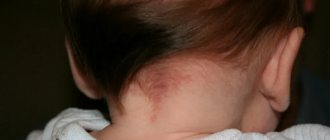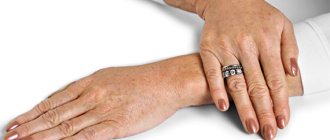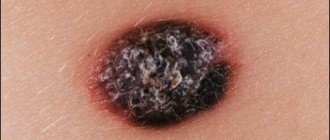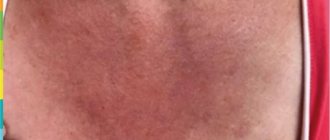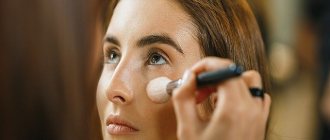Allergy on the face in the form of red spots is a common problem with which patients often turn to dermatologists. To clarify the exact cause of this condition most often requires time and a number of additional studies. To alleviate the condition of allergic dermatitis, modern antiallergic drugs are used, which include Cetrin.
Symptoms
It is quite easy to suspect an allergic reaction in yourself or your child. In addition to the presence of an allergic rash on the face, the following complaints are noted:
- Severe itching or burning;
- Dryness, flaking of the skin;
- Swelling of the eyelids, lips;
- lacrimation;
- Itching and redness of the eyes.
The rash itself may be in the form of red spots or blisters filled with transparent contents. Sometimes an allergic rash looks like small grouped dots that rise above the surface of the skin. If the rash appears after consuming any product, then symptoms may include nausea, vomiting, diarrhea, and abdominal pain1.
Causes
The main reasons for the appearance of red spots on the skin of the face:
- Direct skin contact with an allergen (cream, face mask, decorative cosmetics, soap, jewelry, etc.);
- Food allergies;
- Allergy to medications;
- Allergy to sun or cold;
- Eczema1.
To prevent the appearance of a rash in the future, it is necessary to accurately determine the cause of the allergy and eliminate contact with this substance.
Contact dermatitis
Contact dermatitis rashes are most often localized on the hands or face. An allergic reaction can be triggered by:
- Skin care products. It is important to pre-test creams, masks, lotions and other new products by applying a small amount of product to the inner surface of the forearm for 15-20 minutes.
- Decorative cosmetics. Contains a large number of coloring pigments, fragrances and preservatives. People with sensitive skin prone to dryness and irritation are more prone to allergic reactions.
- Plant pollen. When pollen from plants to which a person is allergic comes into contact with the skin, a rash, itching and other unpleasant symptoms may appear.
Red spots may appear either immediately after contact with the allergen or after some time (usually within 24-48 hours). If you find the cause of the allergy in time and stop using the inappropriate product, then no negative health consequences will be noted.
Erythematous-telangiectatic form -
Clinical features - this type is characterized by either the appearance of persistent erythema (i.e. redness) in the middle third of the face, or frequent but quickly passing attacks of hyperemia. Hyperemia differs from erythema primarily in its duration - it tends to pass quickly, while the severity of redness during hyperemia can be from moderate to very intense. In addition, patients often complain of small blood vessels visible through the skin (telangiectasia), as well as swelling of the face, roughness of the skin or peeling, and a feeling of tightness.
Telangiectasia with rosacea: photo
In this form, most patients associate a sharp deterioration in their condition with exposure to irritating factors - drinking hot drinks, spicy food, exposure to the sun, heat, etc. As a rule, these patients have sensitive skin and therefore, in response to the application of various products to the surface of the skin, they develop There is often a burning and tingling sensation in the skin. Many patients with this type of rosacea do not believe that they are sick with anything and do not seek qualified help (24stoma.ru).
Treatment regimens for erythematotelangiectatic form –
| Expressiveness | Treatment |
| Mild course - characterized by weak persistent erythema or not too frequent mild short-term outbreaks of hyperemia. There are rare telangiectasias. |
|
| Moderate course - moderate persistent erythema or frequent unpleasant outbreaks of hyperemia are observed. There are several well-defined telangiectasias. | In addition to the above:
|
| Severe course - pronounced persistent erythema or frequent severe hyperemia is observed. There may be tissue swelling in the area of redness. There are many well-defined telangiectasias. Patients may complain of burning, tingling, skin peeling, or plaque formation. | In addition to the above:
|
* The effectiveness of drugs with brimonidine was confirmed in clinical studies “Fowler J, Jackson M, Moore A, published in the journal Drugs Dermatol 2013; 12: 650-656."
Rosacea on the face: treatment of the erythematotelangiectatic form (before and after photos)
Allergies to foods and medications
Food allergies on the face are quite common, especially in children. The most allergenic foods are peanuts, eggs, seafood, citrus fruits, and dairy products. However, in the presence of individual intolerance, an allergy can develop to any other food product.
Main symptoms:
- blotchy rash on the face or body;
- Severe itching;
- Peeling of the skin;
- Nausea, vomiting;
- Stool disorders;
- Abdominal pain.
Another important problem is drug allergies. An allergic reaction may occur to a medicine in the form of a tablet, injection, or ointment. Allergies to antibiotics, antiseptics, and nonsteroidal anti-inflammatory drugs are common. The symptoms are the same as those of a food allergy. In severe cases, complications such as angioedema or anaphylactic shock may develop2. You need to know what drugs you are allergic to and warn doctors or medical staff about it.
Phymatous form (rhinophyma) –
Phymatous changes are called thickening of the skin (mainly in the nose area) - with the appearance of roughness, irregularities, and nodules on it. The thickening can be pronounced and then it leads to partial disfigurement of the face. Occurs more often in men, because they are less likely to seek medical help in the early stages of the disease. Thickening of the skin of the nose is called rhinophyma. Rarely, the phymatous form can be observed on the chin, forehead, cheeks, ears and eyelids.
Also, with this form, telangiectasia and hyperplasia of the sebaceous glands can occur. In the dermal layer of the skin, a dense inflammatory infiltrate is observed, in place of which then, for example, tissue proliferation and fibrosis occurs with the formation of nodes. There are several histological types of rhinophyma, for example, fibrous, glandular, fibroangiomatous, etc.
Treatment regimens for the phymatous form –
| Expressiveness | Treatment |
| Mild course - an increase in skin thickness, but without changes in contours |
|
| Moderate flow - there is a change in contours, but without a nodal component | In addition to the above:
|
| Severe flow - there is a change in contours with a nodal component |
Rhinophyma: removal of excess tissue with a CO2 laser
Allergy to sun or cold
Natural factors can also cause the development of allergic reactions. Photoallergy or sun allergy most often occurs in the warm season - from late spring to early autumn. Sometimes an allergic rash is confused with sunburn, but the allergic nature of the disease is characterized by severe itching, the appearance of small, white pustules, and spotty red rashes even after a short stay in the open sun. In such cases, you need to apply sunscreen, protect exposed skin with clothing made from natural fabrics, and wear a hat3.
Allergy to cold or cold urticaria also occurs. During the cold season, red itchy rashes, peeling, and a feeling of tightness appear on the skin of the face and hands. Symptoms may persist for several hours or several days after exposure to the cold. Typically, allergies develop at temperatures from 10 degrees below zero, but it also happens at temperatures close to zero.
Eczema
Eczema is an inflammatory skin disease that tends to be chronic and relapsing. Often the symptoms of eczema are confused with allergic reactions, since the rashes can be similar in appearance. Eczema is characterized by the appearance of bright red spots and swelling of the skin. Grouped bubbles with transparent contents appear on a red background, after which crusts form.
The occurrence of the disease is associated with mechanical damage to the skin, microbial or fungal infection, and occupational hazards. Complex immune reactions characteristic of allergies also take part in the development of pathology.
The nose is red - it's the liver
It is generally accepted that a red nose appears in people who hardly eat while drinking alcohol. It's more of a joke. Although, indeed, when drinking alcohol, the nose becomes red.
But how to evaluate it when the nose is red and the person does not drink? Typically, a red nose indicates liver damage. This suspicion is confirmed by erythema on the inner sides of the palm. Spider veins appearing on the forehead also indicate problems with the liver.
And if a network of thin vessels previously appeared on the chest, arms or shoulders, then these symptoms indicate significant liver damage. A visit to the doctor in such a situation should under no circumstances be postponed.
ONLINE REGISTRATION at the DIANA clinic
You can make an appointment by calling the toll-free phone number 8-800-707-15-60 or filling out the contact form. In this case, we will contact you ourselves.
Treatment
Treatment for facial allergies must include a safe and effective antihistamine3. Cetrin is widely used for seasonal allergies and various forms of allergic dermatitis. The main active ingredient of the drug is cetirizine hydrochloride, which is a histamine antagonist. The advantages of the drug include:
- Quick effect. Onset of action 20 minutes after administration.
- Duration of action. The drug is taken once a day and is effective for 24 hours.
- Good tolerance. Cetrin is well tolerated by patients and causes less drowsiness than first-generation drugs1.
The drug helps eliminate itching, swelling, and redness of the skin. Available in tablet form, approved for use in children over 6 years of age. If you suspect an allergic rash, taking Cetrin is a simple, safe way to make you feel better before you can see a doctor.
Factors that trigger rosacea outbreaks –
The following list of triggers that can lead to rosacea flare-ups was compiled based on clinical research and published by the National Rosacea Society (USA).
| Factors that can cause rosacea flare-ups | ||
| Products - liver, yogurt, sour cream, cheese (except cottage cheese), chocolate, vanilla, soy sauce, yeast (bread is fine), vinegar, eggplant, avocado, spinach, beans and peas, citrus fruits, tomatoes, bananas, red plums, raisins or figs, spicy and too hot foods. Emotional states – stress, anxiety. | Medicines – some analgesics, vasodilators, steroids. Skin care products – cosmetics and hair sprays containing alcohol, witch hazel, fragrance, menthol, peppermint, eucalyptus oil, or any substance that causes redness or burning. Beverages - any alcohol (especially red wine), hot drinks, hot chocolate, coffee or tea. | Weather – exposure to the sun, strong wind, cold, high humidity. Temperature – sauna, hot baths, simple overheating, excessively warm environment. Medical conditions – menopause, cough, caffeine withdrawal syndrome. Exercise stress - active sports, work with a load, work in an incline. |
Importance of various factors –
Below we will divide these factors by strength (from the strongest to the weakest). Next to each factor, you will see the percentage of people for whom this factor was significant and almost certainly led to the development of a rosacea outbreak. This list is based on a survey of more than a thousand patients, and is also published by the National Rosacea Society.
In what percentage of cases do factors lead to exacerbations -
- sun exposure – 81%,
- emotional stress – 79%,
- hot weather – 75%,
- wind – 57%,
- heavy exercise – 56%,
- alcohol consumption – 52%,
- hot baths – 51%,
- cold weather – 46%,
- spicy food – 45%,
- humidity – 44%,
- high body temperature – 41%,
- some skin care products – 41%,
- hot drinks – 36%,
- certain cosmetics – 27%,
- medicines – 15%,
- medical conditions (see above) – 15%,
- some fruits – 13%,
- marinated meat – 10%,
- some vegetables – 9%,
- dairy products – 8%,
- other factors – 24%.
Skin care and cosmetics –
Gentle skin care and effective use of cosmetics can improve the appearance of your skin, but you should use products that are suitable for sensitive skin. Avoid any products that cause burning, redness or irritation. It is worth abandoning chemical and mechanical peeling products. In addition to irritants, components that provoke outbreaks of rosacea include:
- alcohol,
- witch hazel,
- flavorings,
- menthol,
- peppermint,
- Eucalyptus oil.
Try to use products that do not contain fragrances or strong preservatives. Always read the ingredient list carefully. Do not use many different products at once. Before using the product on your face, test it on your neck. In addition, please note that patients with rosacea, especially in winter (as well as in dry air indoors or outdoors), need to regularly use skin moisturizing creams. This will reduce skin irritation and reduce the risk of flare-ups.
Men's shaving and aftershave products – Shaving can be a big challenge for men with rosacea, so one option is to use an electric razor. You should also avoid using any shaving or aftershave lotions or products that contain alcohol, menthol or other irritants. Use gentle aftershave balms to soothe and hydrate your skin.
Sun protection –
Exposure to active solar radiation is the main factor causing flare-ups of rosacea and the appearance of telangiectasia. There are 2 types of damaging sun rays – UVA radiation and UVB radiation. Solar radiation consists of approximately 96.5% radiation of the first type, and 3.5% of the second type. UVA rays penetrate deeper into the skin, they lead to skin aging, the development of melanomas and affect the skin throughout the day.
Despite the fact that UVB rays are small (only 3.5%) they contribute to the development of skin cancer. Patients with rosacea need to choose sun protection products that protect against two types of radiation at once, with an SPF of 15 or higher. Sunscreens with mineral rather than chemical components will have minimal irritating effects on the skin. These components include zinc oxide and titanium dioxide. Apply these products every day when you go outside.
If you plan to stay in intense sun, apply the cream every 2 hours, and also every time immediately after swimming or heavy sweating. But even following these recommendations, you should limit your exposure to the sun in the summer, and try not to stay in the sun for long periods between 10 a.m. and 4 p.m. Our article: Facial Rosacea Causes and Treatment is based on clinical studies published by the National Rosacea Society (USA), and we hope you found it useful!
Sources:
1. Textbook of dermatology “Fitzpatrick's Dermatology” (8th edition), 2. American Academy of Dermatology (USA), 3. National Rosacea Society (National Rosacea Society, USA), 4. “Comparative assessment of the effectiveness of various methods of treating rosacea” (Pearl).
